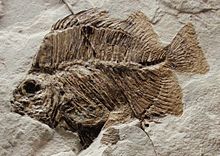
The foxface rabbitfish, also known as the foxface, black-face rabbitfish or common foxface, is a species of marine ray-finned fish, a rabbitfish belonging to the family Siganidae. It is found in the Indian and Pacific Oceans. It can be found in the aquarium trade.

Scatophagus argus, the spotted scat, butterfish, mia mia, spotted butterfish or tiger scat, is a species of fish in the scat family Scatophagidae. It occurs in two basic color morphs which are called green scat and ruby or red scat. This fish is generally distributed around the Indo-Pacific region, to Japan, New Guinea, and southeastern Australia. They live in coastal muddy areas, including estuaries, mangroves, harbours, and the lower courses of rivers. They are popular aquarium fish.

The bicolored foxface, also known as the Uspi rabbitfish, is a species of marine ray-finned fish, a rabbitfish belonging to the family Siganidae. It is found at coral reefs in Fiji in the Pacific Ocean. It occasionally makes its way into the aquarium trade.
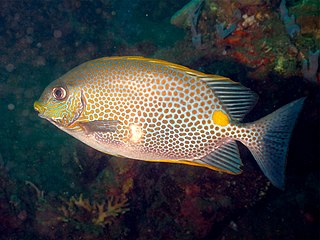
The orange-spotted spinefoot, also known as the deepbody spinefoot, gold-saddle rabbitfish, golden rabbitfish, golden-spotted spinefoot, goldlined spinefoot or yellowblotch spinefoot, is a species of marine ray-finned fish, a rabbitfish belonging to the family Siganidae. It is found in the eastern Indian Ocean and western Pacific Ocean. It occasionally makes its way into the aquarium trade.
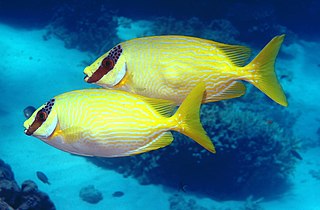
The masked spinefoot, also known as the masked rabbitfish, bluelined rabbitfish, blue-lined spinefoot, decorated rabbitfish or maiden spinefoot, is a species of marine ray-finned fish, a rabbitfish belonging to the family Siganidae. It occurs in shallow, coral-rich areas of clear lagoons and seaward reefs of the Indo-West Pacific region.

The streaked spinefoot, also known as the Java rabbitfish, blue-spotted spinefoot, blue-spotted trevally, Java spinefoot or white-spotted rabbit-fish, is a species of marine ray-finned fish, a rabbitfish belonging to the family Siganidae. It is found throughout most of the Indo-Pacific region.

Chaetodipterus is a genus of marine ray-finned fishes belonging to the family Ephippidae, the spadefishes. These fishes are found in the Atlantic and eastern Pacific Oceans.

The golden-lined spinefoot, also known as the goldlined rabbitfish or lined rabbitfish, is a species of marine ray-finned fish, a rabbitfish belonging to the family Siganidae. It is found in the tropical Western Pacific and along the coasts of northern Australia.

The vermiculated spinefoot, also known as maze rabbitfish, scribbled spinefoot or vermiculate rabbitfish, is a species of marine ray-finned fish, a rabbitfish belonging to the family Siganidae. Like all rabbitfishes, it has venomous spines on the dorsal, anal, and pelvic fins. It is a reef associated fish species of the Indo-West Pacific region. It is a common commercially important fish in many tropical countries.

Scatophagus is a genus of ray-finned fishes belonging to the family Scatophagidae. They are found in the Indo-Pacific region. Species in this genus are referred as spotted scats.

The spotbanded scat,(Selenotoca multifasciata), also known as the striped scat, banded scat, barred scat, butterfish, John Dory, Johnny Dory, old maid, Southern butter-fish or striped butterfish, is a species of ray-finned fish, belonging to the family Scatophagidae, the scats. They are found in the eastern Indian Ocean and southwestern Pacific Ocean.

Scatophagus tetracanthus, the scatty or African scat is a species of ray-finned fish belonging to the family Scatophagidae, the scats. It is found in eastern Africa and Madagascar and in New Guinea and northern Australia.
Siganus labyrinthodes, the labyrinth spinefoot, is a little known species of marine ray-finned fish, a rabbitfish belonging to the family Siganidae. It is found in the eastern Indian Ocean and western Pacific Ocean.
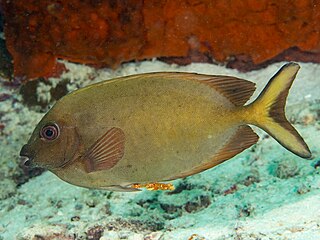
The peppered spinefoot, also known as the finespotted rabbitfish, is a species of marine ray-finned fish, a rabbitfish belonging to the family Siganidae. It occurs in the Indo-West Pacific region.

Siganus punctatus the goldspotted spinefoot, goldspotted rabbitfish, punctuated spinefoot, spotted rabbitfish, spotted spinefoot or yellow-spotted spinefoot, is a species of marine ray-finned fish, a rabbitfish belonging to the family Siganidae. It occurs in the Indo-West Pacific region.

Siganus randalli, the variegated spinefoot or Randall's rabbitfish, is a species of marine ray-finned fish, a rabbitfish belonging to the family Siganidae. It is found in the Western Pacific Ocean.

Siganus spinus, the little spinefoot, scribbled rabbitfish, blunt-nosed spinefoot, spiny rabbitfish or spiny spinefoot, is a species of marine ray-finned fish, a rabbitfish belonging to the family Siganidae. It is found in the Indo-Pacific region.

Siganus stellatus, the brown-spotted spinefoot, brown-spotted rabbitfish, honeycomb rabbitfish, starspotted spinefoot, starspotted rabbitfish or stellate rabbitfish is a species of marine ray-finned fish, a rabbitfish belonging to the family Siganidae. It is found in the Indo-Pacific region.
Siganus woodlandi is a species of marine ray-finned fish, a rabbitfish belonging to the family Siganidae. It is endemic to the waters off New Caledonia in the Western Pacific Ocean.
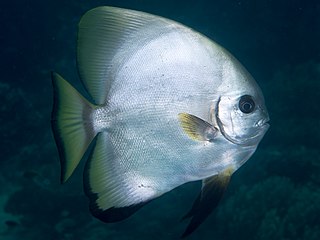
Platax boersii, the golden spadefish or Boers’ batfish, is a species of marine ray-finned fish belonging to the family Ephippidae, the spadefishes and bay fishes. This species is found in the Indo-West Pacific.

